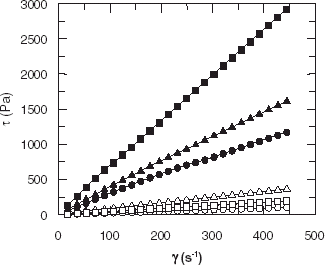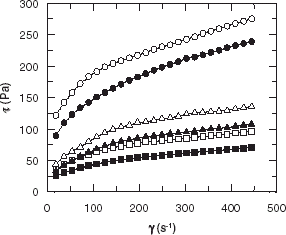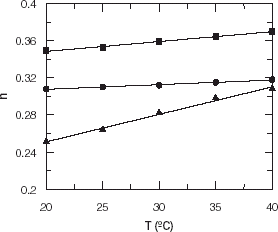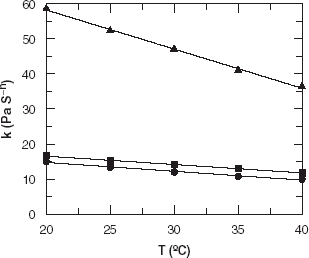Abstract
A comparative study of different commercial sauces was carried out from a rheological point of view. The different sauces were divided into sweet and salad, and for each sausage the behavior was studied at different temperatures. The power-law parameters, n and k, for sauces were calculated and their variation with the temperature was studied. On the other hand, the activation energy was calculated for the sweet sauces.
Introduction
The increasing social and economic importance of food production, together with the complexity of technology of production, processing, handling, and acceptance of these highly perishable and fragile food materials requires a more extensive knowledge of their physical properties; because of this, the viscoelastic properties play an important role in the handling and quality attributes of both minimally processed foods, such as fruits and vegetables, and fabricated foods such as sauces and frankfurters. One of the important characteristic of viscoelastic behavior is the dependence of the material properties on time, in addition to temperature and moisture content.Citation1 The rheological properties are very important in order to design food processing operations (mixing, pumping, heating, cooling),Citation2 Citation3 Citation4 Citation5 and in aspects such as the product acceptance by the consumerCitation6 and the optimization of process variables.Citation7 Citation8
Most foods are complex multicomponent systems, often containing more than one phase and many of these systems exist in the form of emulsions, for example mayonnaise, ketchup, or syrup. The processing of emulsions is a highly complex operation with many variables influencing the processing performance and the final product form.Citation1 In order to understand and eventually improve the processing performance of food emulsions, a sound understanding of their flow behavior is necessary. Because of their commercial importance, the role of the various components: oil, water, egg yolk, thickening agents (usually gums), salt, and sugar have been studied by food technologists and summarized in some publications.Citation6 Citation7 Citation8 Citation9 Citation10 Citation11
The substances studied in this work are natural and commercial honey, caramel, mayonnaise, ketchup, and mustard. The authors carried out an investigation to study the rheological properties of different kind of sauces at different temperatures. Sauces were divided into two groups based in their kind of flow: Newtonian and non-Newtonian fluidsCitation12 using the Herschel-Bulkley model.Citation13
Materials and Methods
All sauces were employed in their commercial form. The mayonnaise contained the following ingredients: girasol oil, egg yolk, vinegar, water, sugar, salt, spices, and stabilizer (E-412). The ingredients of the ketchup are: water, tomato paste, sucrose, spirit vinegar, salt, thickener (E-1422), spices, and aromas. The mustard was constituted by: water, spirit vinegar, mustard, sugar, salt, and spices. The ingredients of the caramel were: syrup of glucose, water sugar, and conservator (E-202). The two honeys had only an ingredient: honey. The composition, moisture content, and pH of all sauces are reported in Table .
Table 1 Composition, moisture content, and pH of the sauces
Different rheological measurements were carried out for all the sauces using a rotational viscosimeter HAAKE VT550, based in two coaxial cylinders, with a temperature sensor PT100. The viscosimeter is connected to a thermostated bath to maintain constant temperature during the measurement. The shear rate range was varied from 18 to 445 s−1. The temperature was varied from 20 to 40°C.
Results and Discussion
Sweet Sauces
The employed sweet sauces were natural and commercial honey and caramel. To study the rheological behavior of these substances, the shear stress (τ) against shear rate (γ) was represented (Fig. ). It was observed that the shear stress changed lineally with the shear rate and shear stress decreased when the temperature increased.
Figure 1. Shear stress vs. shear rate for the sweet sauces at different temperatures: commercial honey (•), natural honey (▪), caramel (▴) at 20°C, and commercial honey (ˆ), natural honey (□), caramel (▵) at 40°C.

Because of this, it is deduced that these sauces present a Newtonian behavior and n have a value of 1. The values of the viscosity, that are equal to the values of consistence index, are obtained with the slope and they are reported in Table . Once the values of the viscosity for this kind of sauces were calculated, the activation energy was obtained with the Eq. (Equation2).
Table 2 Values of coefficients in Herschel-Bulkley fluid model for the sauces
Table 3 Values of activation energy for sweet sauces
Salad Sauces
The employed salad sauces were mayonnaise, ketchup, and mustard. Based on the dependence of the shear stress on the shear rate, the type of solutions was determined. From the typical curves on dependence of the shear stress (τ) on shear rate (γ) it could be seen that all of these substances had a non-Newtonian and pseudoplastic behavior and therefore the shear stress decreases with the temperature (Fig. ). Another form of studying the Newtonian or non-Newtonian behavior of a fluid would be to represent the viscosity against the shear rate and analyze its behavior.Citation14 In this case, the variation is exponential, and therefore we are working with non-Newtonian fluids; otherwise, the variation should be lineal. This indicates that the viscosity of the three salad sauces must decrease when the temperature increases. Once analyzed their behavior, Herschel-Bulkley model was used to determine the consistence and behavior indexes, k and n, respectively and the variation of the both indexes with the temperature was analyzed. These indexes have a similar and opposed behavior with the temperature for all these sauces. Consequently, n, increases lineally with the temperature (Fig. ) and k decreases lineally when increasing the operation temperature (Fig. ). Therefore, they can be fitting to the Eqs. (Equation3) and (Equation4).
Table 4 Fitting parameters of the behavior and consistence indexes with the temperature for salad sauces
Figure 2. Shear stress vs. shear rate for the salad sauces at different temperatures: mayonnaise (•), mustard (□), ketchup (▵) at 20°C, and mayonnaise (•), mustard (▪), ketchup (▴) at 40°C

Conclusions
The obtained results allow concluding that the studied sweet sauces have a Newtonian behavior while the studied salad sauces have a non-Newtonian and pseudoplastic behavior. The value of the activation energy for sweet sauces was determined and it is observed that the value of commercial honey is very much higher than the natural honey. The liquid caramel has an intermediate value. The rheological parameters, n and k, were calculated for the salad sauces. It is concluded that on the one hand, the behavior index, n, increases lineally with the temperature and on the other hand, the consistence index decreases lineally when the temperature increases.
References
- Rao , M.A. and Steffe , J.F. 1992 . Viscoelastic Properties of Foods London : Elsevier Applied Science .
- Brennan , J.G. , Butters , J.R. , Cowell , N.D. and Lilly , A.E.V. 1980 . Las Operaciones de la Ingeniería de Los Alimentos, , Ed. Acribia, Zaragoza
- Dail , R.V. and Steffe , J.F. 1990a . Rheological characterization of cross-linked waxy maize starch solutions under low acid aseptic processing conditions using tube viscosimetry techniques . Journal of Food Science , 9 : 151 – 191 .
- Dail , R.V. and Steffe , J.F. 1990b . Dilatancy in starch solutions under low acid aseptic processing conditions . Journal of Food Science , 55 : 1764 – 1765 .
- Abdelrahim , K.A. , Ramaswamy , H. , Doyon , G. and Toupin , C. 1994 . Effects of concentration and temperature on carboxymethylcellulose rheology . International Journal of Food Science and Technology , 29 : 243 – 253 . [CSA]
- Harrison , L. and Cunningham , F. 1985 . Factors influencing the quality of mayonnaise: a review . Journal of Food Quality , 8 : 1 – 20 .
- Franco , J.M. , Algeciras , J.L. , Trujillo , J.E. , Flores , V. and Gallegos , C. 1994 . Influencia del procesado en la estabilidad de emulsiones alimentarias aceite en agua de bajo contenido en aceite . Alimentación, Equipos y Tecnología , 13 ( 3 ) : 61 – 66 .
- Franco , J.M. , Guerrero , A. and Gallegos , C. 1995 . Influencia de las concentraciones de aceite y emulsionante en las propiedades reológicas de emulsiones aceite en agua del tipo salsa fina . Grasas y Aceites , 46 ( 2 ) : 108 – 114 .
- Harrison , L. and Cunningham , F. 1986 . Influence of frozen storage time on properties of salted yolk and its functionality in mayonnaise . Journal of Food Quality , 9 : 167 – 174 .
- Sánchez , M.C. and Guerrero , A. 1998 . Influencia de la composición y del procesado sobre la reología de emulsiones . Afinidad LV , 476 : 259 – 266 .
- Miranda , J. , Guerrero , A.F. and Partal , P. 2000 . Reología de derivados de la yema de huevo deshidratada . Grasas y Aceites , 51 ( 4 ) : 244 – 250 .
- Martínez , A.B. 1988 . Introducción a la Reometría Capilar de Polímeros Barcelona : Universitat poletécnica of Catalunya . Editorial lit
- Herschel , W.H. and Bulkley , R. 1926 . Measurement of consistency as applied to rubber-benzene solutions . Proc. Am. Soc. Testing Materials , 82 : 9
- Bohme , G. 1987 . Non-Newtonian Fluid Mechanics, , Ed. Elsevier .

